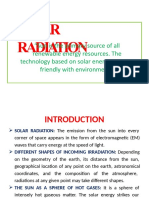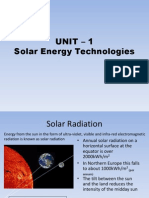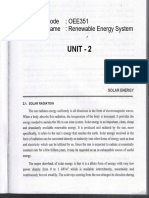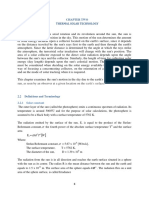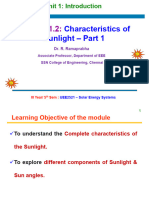Solar Energy Reaching The Earth's Surface
Uploaded by
crocoreaderSolar Energy Reaching The Earth's Surface
Uploaded by
crocoreader2.
Solar Energy Reaching The Earths Surface
2.1. The Solar Constant
The Sun is considered to produces a constant amount of energy. At the surface of the Sun the
intensity of the solar radiation is about 6.3310
7
W/m
2
(note that this is a power, in watts, per unit
area in meters). As the Sun's rays spread out into space the radiation becomes less intense and by
the time the rays reach the edge of the Earth's atmosphere they are considered to be parallel.
Figure 2.1: The Sun's rays incident on the Earth. I
0
= irradiance on a plane perpendicular to the Sun's rays
The solar constant (I
SC
) is the average radiation intensity falling on an imaginary surface,
perpendicular to the Sun's rays and at the edge of the Earth's atmosphere (figure 2.1). The word
'constant' is a little misleading since, because of the Earth's elliptical orbit the intensity of the solar
radiation falling on the Earth changes by about 7% between January 1
st
, when the Earth is nearest
the Sun, and July 3
rd
, when the Earth is furthest from the Sun (figure 1.2). A yearly average value is
thus taken and the solar constant equals 1367 W/m
2
. Even this value is inaccurate since the output
of the sun changes by about 0.25% due to Sun spot cycles.
The solar radiation intensity falling on a surface is called irradiance or insolation and is measured
in W/m
2
or kW/m
2
. The solar constant can be used to calculate the irradiance incident on a surface
perpendicular to the Sun's rays outside and the Earth's atmosphere (figure 2.1) on any day of the
year (i.e. as the distance between the Sun and Earth changes thought the year):
1
]
1
,
_
+
25 . 365
n
2 cos 034 . 0 1 I I
SC 0
(2.1)
Where:
I
0
= extraterrestrial (outside the atmosphere) irradiance on a plane perpendicular to the Sun's rays
(W/m
2
),
I
SC
= the solar constant (1367 W/m
2
),
n = the day of the year such that for January the 1
st
n = 1.
Figure 2.2 shows the variation in I
0
over the course of a year. Most solar power calculations use I
0
as a starting point because, for any given day of the year it is the maximum possible energy
obtainable from the Sun at the edge of the Earth's atmosphere.
Figure 2.2: The variation in I
0
over the course of a year. The dashed line shows the value of the solar constant (I
SC
).
2.2. The Cosine Effect
The value of I
0
is the same no matter where you are on the Earth's surface, however not all points on
the Earth's surface are perpendicular to the Sun's rays. A useful quantity to calculate is the solar
irradiance incident on an imaginary surface that is parallel to a horizontal plane on the Earth's
surface (figure 2.2). The irradiance on such a surface is smaller than I
0
because of the cosine effect
and is the maximum amount of solar energy that could be collected on a horizontal plane at the
Earths surface if the atmosphere did not scatter and absorb any radiation..
Figure 2.2: The cosine effect.
Figure 2.2 shows three plane surfaces:
plane A, a horizontal plane at the point P on the Earth's surface;
plane B, a surface parallel to plane A but on the edge of the Earth's atmosphere, often referred to
as the horizontal plane;
plane C, a surface perpendicular to the Sun's rays, often referred to as the normal plane.
I
0
is the irradiance intensity on the normal plane and the irradiance intensity on the horizontal plane
can be calculated from:
Z h 0
cos I (2.2)
Where
Z
is the solar zenith angle described in section 1.2 and I
0h
is the extraterrestrial irradiance
intensity on a horizontal plane. It can be seen Irom Iigure 2.2 that
Z
is also the angle of incidence
of the Sun's rays on a horizontal plane. Note that since cosine values fall between 1 and 1, I
0h
will
never be greater than I
0
, and I
0h
= I
0
at point P' where cos
Z
1 (
Z
= 0).
2.3. Irradiation
Just to be confusing the intensity of solar radiation is called irradiance and is measures in the units
of power per unit area (W/m
2
or kW/m
2
) however, the total amount of solar radiation energy is
called irradiation and is measures in the units of energy per unit area (J/m
2
). Irradiation is given the
symbol H, so that:
H
0
is the total daily amount of extraterrestrial radiation on a plane perpendicular to the Sun's
rays;
H
0h
is the total daily amount of extraterrestrial radiation on a plane horizontal to the Earth's
surface.
Note that these planes are considered to rotate with the Earth so that H
0
and H
0h
are daily values,
and the planes are shaded at night.
Figures 2.3 and 2.4 shows how the values of H
0
and H
0h
varies throughout the year in the northern
hemisphere. Note that for any given day the value of H
0
changes from latitude to latitude despite the
value of I
0
being constant for all latitudes. This occurs because the length of the days changes and
the effects is most obvious inside the Arctic circle where much of the year is either 24 hours of
darkness or 24hours of daylight.
Figure 2.3: The total daily amount of extraterrestrial irradiation on a plane perpendicular to the Sun's rays (H
0
) for
different latitudes.
Figure 2.4: The total daily amount of extraterrestrial irradiation on a plane horizontal to the Earth's surface(H
0h
) for
different latitudes.
2.4. The Solar Spectrum
The Sun's radiation is a good approximation of black body radiation (a continuous distribution of
wavelengths with no wavelengths missing) with wavelengths in the range of about 0.2 m to 2.6
m (figure 2.5). The solar spectrum consists of ultra violate rays in the range of 200 to 400 nm,
visible light in the range 390 nm (violet) to 740 nm (red) and the infra red in the range 700 nm to
1mm. Table 2.1 shows the subdivisions of the ultra violate range and table 2.2 shows the
distribution of extraterrestrial solar radiation.
UV-A 320-400 nm Not harmful in normal doses, vitamin D production.
UV-B 290-320 nm Tanning, can burn.
UV-C 230-290 nm Causes skin cancer.
Table 2.1: Ultra violate radiation.
Ultra Violet 200-400 nm 8.7%
Visible 400-700 nm 38.3%
Near Infra Red 700-3500nm 51.7%
Table 2.2: The distribution of extraterrestrial solar radiation.
As the Sun's rays pass through the atmosphere certain wavelengths are absorbed and a proportion of
the total energy is scattered. Thus the solar spectrum at the Earth's surface has some wavelengths
missing (shown blacked out in figure 2.5) and the overall intensity is reduced.
2.5. The Atmosphere And Air Mass
The atmosphere scatters and absorbs some of the Sun's energy that is incident on the Earth's surface.
Scattering of radiation by gaseous molecules (e.g. O
2
, O
3
, H
2
O and CO
2
), that are a lot smaller than
the wavelengths of the radiation, is called Rayleigh scattering. Roughly half of the radiation that is
scattered is lost to outer space, the remaining half is directed towards the Earth's surface from all
directions as diffuse radiation. Because of absorption by oxygen and ozone molecules the shortest
wavelength that reaches the Earth's surface is approximately 0.29 m. Other gas molecules
absorbed difference wavelengths as indicated in figure 2.5.
Figure 2.5: The extraterrestrial solar spectrum (AM = 0), the theoretical black body curve and the solar spectrum at the
Earth's surface for AM = 2 and the absorbed regions shown in black.
Scattering by dust particles larger than wavelengths of light is called Mie scattering. This process
includes both true scattering (where the radiation bounces of the particle) and absorption followed
by emission, which heats the particles. The amount of radiation scattered by this process will vary a
lot depending on location and the weather blowing particles about. A form of Mie scattering called
the Tyndall effect, that preferentially scatters shorter wavelengths is responsible for the sky being
blue.
Clouds reflect a lot of radiation and also absorbed a little, the rest is transmitted through. Globally,
clouds reflect a lot of radiation and help regulate the surface temperature.
Figure 2.6: The effect of the atmosphere on the solar radiation reaching the Earth's Surface.
The fraction of the total solar radiant energy reflected back to space from clouds, scattering and
reflection from the Earth's surface is called the albedo of the Earth-atmosphere system and is
roughly 0.3 for the Earth as a whole. Figure 2.6 shows that a plane on the Earth's surface receives:
Beam (or direct) radiation coming straight through the atmosphere to hit the plane (very
directional);
Diffused radiation scattered in all direction in the atmosphere and then some arrives at the
plane on the Earths surface (not directional);
Reflected radiation beam and diffused radiation that hits the Earth's surface and is reflected
onto the plane.
The amount of energy reflected, scattered and absorbed depends on the amount of atmosphere that
the incident radiation travels through as well as the levels of dust particles and water vapour present
in the atmosphere. The latter is difficult to judge but the distance travelled through the atmosphere
by incident radiation depends on the angle of the Sun (figure 2.7).
Figure 2.7: The distance travelled through the atmosphere by the Sun's rays.
The distance travelled through the atmosphere by the Sun's rays incident on the Earth is accounted
for by a quantity called air mass (AM).
atmosphere the of depth verticle
velled length tra path
mass air
Z
2 / 1
2
Z
cos
H
R
1
H
R
2 cos
H
R
CP
BP
AM
,
_
1
1
]
1
+ +
,
_
(2.3)
Where:
R = the radius of the Earth, taken to be 6370 km;
H = thickness of atmosphere, taken to be 7991 km (although it is considerably thicker at the equator
than the poles).
For angles oI
Z
< 70:
Z
Z
sec
cos
1
AM (2.4)
ThereIore outside the Earth's atmosphere AM 0, when the Sun is directly overhead
Z
= 0, AM =
1 and when the
Z
= 60 AM = 2. AM is normally taken to be an average of 1.5 for a clear sunny
day and this value is used for the calibration of solar cells.
2.6. Rough Estimates Of The Solar Energy Available At The Earth's Surface
The solar constant is the average extraterrestrial insolation at the edge of the atmosphere:
I
SC
= 1367 W/m
2
The Earth presents a disc oI area R
2
to the Sun, therefore the total amount of extraterrestrial
insolation incident on the Earth is I
SC
R
2
. This value is then divided by half the surface areas of
the Earth, 4R
2
/2, which gives 684 W/m
2
, the average insolation incident on unit area of the Earth
facing the Sun (figure 2.8). Note that solar panels are calibrated assuming that there is 1000 W/m
2
available.
Figure 2.8
A rough estimate of the irradiation incident per unit area (H) of the Earth's surface can be made if
we assume that 30% of the Sun's energy is lost in the atmosphere and that the a day is an average of
12 hours long at any location.
day / kWh 75 . 5 12 684 7 . 0 H
Or if we assume that the Sun is only at an appreciable strength for an average 6 hours in the day (as
is likely in more northerly latitudes):
day / kWh 88 . 2 6 684 7 . 0 H
Figure 2.9 shows the yearly profile of mean solar radiation for different locations around the world.
The solid grey line show the value of 5.75 kWh/day and the dashed grey line shows 2.88 kWh/day.
Figure 2.9: The yearly profile of mean solar radiation for different locations around the world.
You might also like
- Ac7114-1 Rev H Audit Criteria For Nondestructive Testing Facility Penetrant Survey-1No ratings yetAc7114-1 Rev H Audit Criteria For Nondestructive Testing Facility Penetrant Survey-133 pages
- Solar Energy Reaching The Earth's Surface The Solar ConstantNo ratings yetSolar Energy Reaching The Earth's Surface The Solar Constant11 pages
- Solar Constant, Beam and Diffuse Radiation, Attenuation of Solar RadiationNo ratings yetSolar Constant, Beam and Diffuse Radiation, Attenuation of Solar Radiation15 pages
- 22ee502 - Conventional and Renewable Energy Systems - Unit 3No ratings yet22ee502 - Conventional and Renewable Energy Systems - Unit 358 pages
- Extraterrestrial and Terrestrial Solar RadiationNo ratings yetExtraterrestrial and Terrestrial Solar Radiation6 pages
- Chapter Two Solar Radiation and Its MeasurementsNo ratings yetChapter Two Solar Radiation and Its Measurements14 pages
- Class Note 1 B - 2B - Radiation and Temperature-1No ratings yetClass Note 1 B - 2B - Radiation and Temperature-123 pages
- Class Note 1 B - 2B - Radiation and Temperature-1No ratings yetClass Note 1 B - 2B - Radiation and Temperature-123 pages
- Solar Irradiance: Solar Radiation Jump To Navigation Jump To Search Insulation (Disambiguation)No ratings yetSolar Irradiance: Solar Radiation Jump To Navigation Jump To Search Insulation (Disambiguation)12 pages
- A Matlab GUI For Calculating The Solar Radiation On Earth100% (3)A Matlab GUI For Calculating The Solar Radiation On Earth12 pages
- Unesco - Eolss Sample Chapters: Solar Radiation Energy (Fundamentals)No ratings yetUnesco - Eolss Sample Chapters: Solar Radiation Energy (Fundamentals)10 pages
- Chapter 1: Solar Radiation: 1.1 Basics of LightNo ratings yetChapter 1: Solar Radiation: 1.1 Basics of Light15 pages
- Classics: Handbook of Solar Radiation Data For IndiaNo ratings yetClassics: Handbook of Solar Radiation Data For India6 pages
- UNIT III - SOLAR PV AND THERMAL SYSTEMSNo ratings yetUNIT III - SOLAR PV AND THERMAL SYSTEMS29 pages
- Zero Point Energy Per Stereo Radian and the Distribution of Gravitational Acceleration of Planets Throughout the Solar System.: The Origin and Cause of GravitationFrom EverandZero Point Energy Per Stereo Radian and the Distribution of Gravitational Acceleration of Planets Throughout the Solar System.: The Origin and Cause of GravitationNo ratings yet
- Template For Extended Abstract ETMN ConferenceNo ratings yetTemplate For Extended Abstract ETMN Conference2 pages
- 2011 University Alliance Design CompetitionNo ratings yet2011 University Alliance Design Competition3 pages
- Nested Classes: Enclosing Class OR Outer ClassNo ratings yetNested Classes: Enclosing Class OR Outer Class23 pages
- CCM - FF-K2.2015 Final Report On The Key ComparisonNo ratings yetCCM - FF-K2.2015 Final Report On The Key Comparison99 pages
- Real Analysis An Introduction to the Theory of Real Functions and Integration 1st Edition Jewgeni H. Dshalalow - The full ebook with all chapters is available for download100% (1)Real Analysis An Introduction to the Theory of Real Functions and Integration 1st Edition Jewgeni H. Dshalalow - The full ebook with all chapters is available for download49 pages
- Finite Element Analysis of Hollow Concrete Block Wall Crack Propagation Under Different Loading Conditions in The Case of Commercial Buildings Bale RobeNo ratings yetFinite Element Analysis of Hollow Concrete Block Wall Crack Propagation Under Different Loading Conditions in The Case of Commercial Buildings Bale Robe83 pages
- Elliptic Systems of Phase Transition Type: Nicholas D. Alikakos Giorgio Fusco Panayotis SmyrnelisNo ratings yetElliptic Systems of Phase Transition Type: Nicholas D. Alikakos Giorgio Fusco Panayotis Smyrnelis349 pages
- Instalación Sensor Turbo Modificación 3-38-14en1No ratings yetInstalación Sensor Turbo Modificación 3-38-14en11 page
- The Physical Principles of Magnetism 1st Edition Allan H. Morrish All Chapters Instant Download100% (4)The Physical Principles of Magnetism 1st Edition Allan H. Morrish All Chapters Instant Download85 pages
- Ac7114-1 Rev H Audit Criteria For Nondestructive Testing Facility Penetrant Survey-1Ac7114-1 Rev H Audit Criteria For Nondestructive Testing Facility Penetrant Survey-1
- Solar Energy Reaching The Earth's Surface The Solar ConstantSolar Energy Reaching The Earth's Surface The Solar Constant
- Solar Constant, Beam and Diffuse Radiation, Attenuation of Solar RadiationSolar Constant, Beam and Diffuse Radiation, Attenuation of Solar Radiation
- 22ee502 - Conventional and Renewable Energy Systems - Unit 322ee502 - Conventional and Renewable Energy Systems - Unit 3
- Solar Irradiance: Solar Radiation Jump To Navigation Jump To Search Insulation (Disambiguation)Solar Irradiance: Solar Radiation Jump To Navigation Jump To Search Insulation (Disambiguation)
- A Matlab GUI For Calculating The Solar Radiation On EarthA Matlab GUI For Calculating The Solar Radiation On Earth
- Unesco - Eolss Sample Chapters: Solar Radiation Energy (Fundamentals)Unesco - Eolss Sample Chapters: Solar Radiation Energy (Fundamentals)
- Classics: Handbook of Solar Radiation Data For IndiaClassics: Handbook of Solar Radiation Data For India
- Introduction to Renewable Energy ManufacturingFrom EverandIntroduction to Renewable Energy Manufacturing
- Zero Point Energy Per Stereo Radian and the Distribution of Gravitational Acceleration of Planets Throughout the Solar System.: The Origin and Cause of GravitationFrom EverandZero Point Energy Per Stereo Radian and the Distribution of Gravitational Acceleration of Planets Throughout the Solar System.: The Origin and Cause of Gravitation
- CCM - FF-K2.2015 Final Report On The Key ComparisonCCM - FF-K2.2015 Final Report On The Key Comparison
- Real Analysis An Introduction to the Theory of Real Functions and Integration 1st Edition Jewgeni H. Dshalalow - The full ebook with all chapters is available for downloadReal Analysis An Introduction to the Theory of Real Functions and Integration 1st Edition Jewgeni H. Dshalalow - The full ebook with all chapters is available for download
- Finite Element Analysis of Hollow Concrete Block Wall Crack Propagation Under Different Loading Conditions in The Case of Commercial Buildings Bale RobeFinite Element Analysis of Hollow Concrete Block Wall Crack Propagation Under Different Loading Conditions in The Case of Commercial Buildings Bale Robe
- Elliptic Systems of Phase Transition Type: Nicholas D. Alikakos Giorgio Fusco Panayotis SmyrnelisElliptic Systems of Phase Transition Type: Nicholas D. Alikakos Giorgio Fusco Panayotis Smyrnelis
- The Physical Principles of Magnetism 1st Edition Allan H. Morrish All Chapters Instant DownloadThe Physical Principles of Magnetism 1st Edition Allan H. Morrish All Chapters Instant Download







